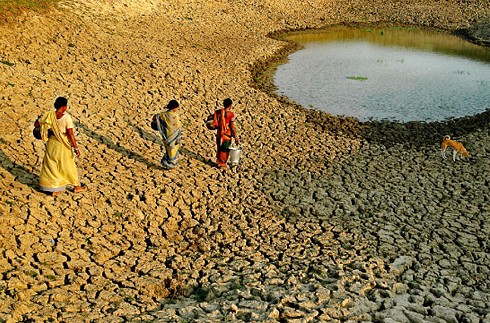Home » Six Kilometers a Day
By Under Secretary of State Maria Otero

AT LONG LAST: Three women finally reach their water source, a low water level lake in India.
Joydeep Mukherjee
Picture for a moment the life of Meliyio Tompoi, a 35-year-old mother of six children, who lives in the Narok district in southwest Kenya. Most of the area's water points are dry, and she must walk 25 kilometers to collect water. This takes six hours each day. Although her household requires about 40 liters of water a day, Meliyio can only carry 15 to 20 liters on her own. So sometimes her familycan only eat once a day due to the lack of water.
Sadly, there are millions of women like Meliyio around the world. While nearly a billion people worldwide live without access to clean water, the crisis disproportionately affects women and girls. As nurturers and homemakers, women bear the overwhelming responsibility of finding and collecting water for their families.
The profound impact a lack of adequate water, sanitation, and hygiene has on a woman's sense of dignity and self-worth extends far beyond the physical hardships associated with the chores themselves:
- On average, women and girls in developing countries walk 6 kilometers (approximately 3.5 miles) a day, carrying 20 liters (approximately 42 pounds/20 kgs) of water. In some areas, it is common for this journey to take more than 15 hours a week.
- Where latrines are not available, women and girls seeking privacy will travel outside their villages after dark, exposing themselves to a greater risk of harassment and sexual assault.
- Female school staff and girls who have reached puberty are less likely to attend schools that lack gender-specific sanitation facilities. Of the 72 million school-age children not attending school around the world, the majority are girls. As a direct result, more than half of the world's illiterate young people are girls1.
But there is hope. Women are incredibly resourceful, resilient, and innovative, and when they are involved in developing solutions, they make decisions that enhance the lives and livelihoods of their families and communities. At ACCION International, I witnessed firsthand the remarkable changes that occur when women living in poverty are provided opportunities. A small micro-loan can make the difference between hunger and prosperity.
Similarly, when women and girls are involved in decisions about the use of water resources, they find innovative ways to create economic opportunities that can dramatically improve their health, access to education, personal empowerment, and living conditions for their families. In Meliyio's case, she participated in a needs assessment that identified water as the top priority for her community. As a result, a USAID-supported project excavated a shallow well just one kilometer away and struck fresh water. It now takes Meliyio just 20 minutes to obtain water, and she and her friends use the time they once spent fetching water on village development activities.
The evidence is clear. If you want to reduce demand for water, you teach women, who bear significant responsibility for tending the world's farms, how to get more crop per drop. If you want to reduce waterborne disease, you give women access to credit and other resources to help them provide safe drinking water and sanitation for themselves and their families. In this issue of Global Waters you will meet African women like Meliyio who are doing just that:
- The women of the Green Belt Movement in Africa have taken Nobel Peace Prize Winner Wangari Maathai 's lead to begin planting trees, which provide multiple resources to their communities: water, wood, and fruit, as well as cover and shade.
- In The Gambia, women have created an income stream for themselves by learning to sustainably harvest oysters through the TRY Association;
- Women in Nigeria, with the help of the Women Farmers Advancement Network (WOFAN), have mastered sustainable farming techniques, leading to empowerment through enterprise, literacy programs, and early childhood development programs;
- Three remarkable AWARD (African Women in Agricultural Research and Development) fellows—women scientists who, with grant dollars and support from USAID and the Consultative Group on International Agricultural Research (CGIAR), are putting their research skills to use developing life-changing innovations to better the health and water quality for their communities.
On World Water Day, Secretary Clinton signed a Memorandum of Understanding among the State Department, the World Bank, USAID, and nearly two dozen other agencies in both the public and private sectors declaring a mutual commitment to collectively address the growing water crisis and find long-term sustainable solutions to this daunting challenge.
This is an important step forward. But we cannot rest until we ensure that all people, from women in Meliyio's village to communities in the mangrove forests of The Gambia, have access to the clean water and sanitation that they and their families deserve. Together, we can achieve a world in which clean water for everyone is no longer a luxury, but a standard.
1 Statistics are from: "Women for Water ~ Water for All" Campaign Fact Sheet, WASH Advocacy Initiative, Spring 2011.







Comment
Make a general inquiry or suggest an improvement.